#the limits makes antagonists more human i think
Note
I was reading The Monkey King's Daughter (you can read the whole book for an hour) and apparently the protagonist is also Guanyin's grandchild? Can Guanyin be shipped?
I mean I can’t say like what are like the moral implications of shipping GuanYin itself cause that is so not my place but I’m still going to answer this cause it kinda of interesting when it comes to modern media. First off saying that like I have never really seen romance done with GuanYin. At least in a serious way. But if I had to take a guess it can be seen as 'possible' as much as like shipping anyone in Chinese mythos, in that isn't really taken seriously at all. In a lot of modern fan spaces there are a variety of crack ships for more humorous or hypothetical situations like I have seen literally the Star of Venus shipped with Jade Emperor just cause. But I don't see much with buddhas or bodhisattvas in either post-modern media nor in fan spaces. At least that isn't Wukong or Sanzang since they are both Buddhas. And I have done a whole thing about how Wukong for decades wasn’t seen as a romantic figure until like there was a huge character reconstruction, but that isn’t usually the case for most characters.
I would say that the most mainstream instance I can think off the top of my head is The Lost Empire (2001) where it had the main character has a romantic plot with Gaunyin herself. Of course, that wasn't really a masterpiece within itself but this was considered like a 'bad choice' more so that it was just a very strange and awkward romance at that.

Funny enough I think I see more romantic for humor's sake on Guanyin in comic books or games as likes gags at most. Like in Westward comics (later a tv series) Guanyin has a celestial-turned-demon trying to pursue him that he always rejects. Another is more play for laughs but Guanyin in the Fei Ren Zai where people just don't know it's Guanyin and think she is so attractive.

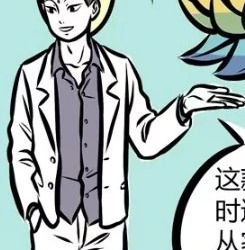
I've seen some games that have Guanyin as like a pretty boy/girl but otherwise nothing even close to a romance plot. Those are more just for like aesthetics of making every character look overly attractive to sell it.
The best I can say is that is just kinda strange and a little strange personally but I can't say that it can be taken seriously. I mean Wukong is supposed to be a Buddha by the end of the novel, so if The Monkey King's Daughter has it that a buddha can have a daughter then there wouldn't be anything stopping the author from having a bodhisattva having kids.
#anon ask#anonymous#anon#ask#sun wukong#monkey king#guanyin#chinese mythos#monkey king's daughter#Wukong is pretty self contained within Xiyouji himself so asking for a little bit of suspension of disbelief can be understood#but Gaunyin has a much longer history that is far more embedded with Buddhist mythology#She isn’t just a character in Xiyouji#and it would be limiting to her just to make it so#but I do think that might be the case in some media when it comes to portraying Gaunyin#esp since most modern interpretations of Guanyin are from xiyouji material just cause the sheer amount of xiyouji content there is#I rarely see Guanyin stand alone moves/shows and there are some trust me but most of her portrayals are within xiyouji spaces#there is a lot of conversation about xiyouji either being a reconstruction or a deconstruction of religion#and while the book is SATURATED in allegorical meaning whether in taoism buddhism or chinese lore it is also seen as satire of religion#people can take xiyouji as pointing out the flaws in humanity but also the flaws of heaven as well as it humanizes both gods and buddhas#this kinda of humanization can be seen as disrespectful to a certain extent but it is what makes these figures more engaging as characters#from a writing standpoint at least#this is me just rambling now about the interesting dycotomy that xiyouji has and has had with religion and how that can be see as today#to a certain extent a lot of directors take xiyouji plots as also their own way to show the heavens in their own way to convey satire#or humor as well depending on what their direction is aiming for#Some even go so far to make that heaven is just straight up the bad guy and that includes buddha as well which is a FAR more wild take than#just having romance in the heavens#But xiyouji does have it that we see these mythological figures have flaws#that heaven can lie or trick or they can take bribes and its up to the audience to interpretation as either satire or if it is critiquing#perhaps religion itself or rather the religious institutions since we do see both daoist and buddist monks as antagonists in the book#this as nothing to do with the ask at this point but i just wanna say my thoughts
11 notes
·
View notes
Text
Thoughts on Mistborn: Shadows of Self
Shadows of Self is incredibly great, heartbreaking, and thought-provoking!
I'm hurt and confused. And I'm not sure how to feel, and I love it for that. Shadows of Self is completely different than its preceding book. It is different from even the Mistborn trilogy. There are themes of the stagnation of political systems, religious tension, the ethics and morals of what line God should, could, might have on interfering with the lives of his creations. After finishing off the book, I genuinely had no idea what to think about Harmony, Trell's puppeteering, Bleeder's campaign, or the state of Elendel.
Something that annoyed me about Era 2's books off the bat was the noble system. There's no state sponsored murder or rape, and the nobles are more like businessmen. But it still felt like nothing changed over the last 340 years. I kept thinking... wow, this is what Kelsier died for?! This is what Vin and Elend fought to protect?! I started off hating everyone - Harmony, the Senate, constables, Wax, even Spook - for not erasing the noble system. But while reading the book I kept thinking about Sazed's limitations due to wielding the Shard of Harmony, his stance on free will, his subtle maneuvering of Wax and Marasi... and kept thinking about real life. I came to the realization that being in the role of God comes with a lot of nuance on guiding mortals. I connected the stagnation of Elendel back to the history of the US... how even though centuries has passed, many abhorrent systems are masked by seemingly more human systems. Governments are still being controlled by nobles and aristocrats, just in a different flavor. Policing has so many issues it could take 1000 years to solve.
Even after finishing the book, I still think the noble system should've been completely erased. But now I'm thinking if that would've fundamentally changed things. The US doesn't have monarchs, nobles, slave plantations, or aristocrats. But corporations, billionaires, politicians, and the upper class get away with a lot, they find ways to obtain power and avoid accountability. Would Harmony be right if he gave the divine mandate of "I DECREE NO NOBLES FOR ALL OF TIME!" At that point is free will a choice?
I started off blaming Harmony for not making a democratic world with no nobles. Ended off having… weird feelings about him. Like... MeLann brings up a great point about the kandra impersonating witnesses to testify against people. If Harmony allowed that, that could be a dangerous precedent.
But then there's Bleeder. Bleeder is easily my favorite antagonist in the series. She's incredibly competent, her body horror is gruesome horrific, and her climax is depressingly tragic. May she rest in the Beyond. Poor Wax. This is the thing that has me feeling weird about Harmony. This hurts cuz of Sazed. Fuck Sazed. Fuck Sazed. I knew Harmony would’ve become a Chessmaster, but not like this. Sazed isn’t supposed to manipulate people. Sazed isn’t supposed to cause trauma to people 😭😢💔💔
But Sazed is, unfortunately, the Hero of Ages. Harmony seems to be foreseeing a great disaster caused by Trell. I’m pretty sure he’s trying to thread towards a future possibility that will save Scadrial from this disaster. He must think about the future of the entire world. It hurts that he moved Wax this way, but would there really have been any difference if he left Wax completely alone? The Set - puppets of a Shard of Adonalsium - would've subtly caused turmoil on Elendel. What if he told Wax he was hunting Lessie? TenSoon said it himself. Harmony saw the future, saw that Wax wouldn't go through with it. Bleeder - another puppet of a Shard - would've succeeded in her goals. Sure he could've maneuvered someone else, but it opens a new can of worms!
I love the hints of Trell being a far scarier antagonist than it appears. I love the advancements and possibilities of Hemalurgy Trell is responsible for. Shadows of Self does a far better job than The Hero of Ages presenting gray morality in the motives and plans of gods. It also does a far better job at presenting a smart and clever antagonistic deity. I think with the conflict between Ruin and Preservation, Sanderson wrote many things that made Ruin appear too much like "the bad guy." He can say Preservation has a dark side, but we never saw it. The one reprehensible thing Preservation could've been completely responsible for - the Deepness killing people - ended up being the result of his frayed mind. He could've been solely responsible for the Deepness covering the Sun and killing plants, but that ended up being caused by Ruin. Ruin spoke with too much malice and joy of killing all life and destroying everything. Apart from his attributes being fundamental aspects of life and the Universe, there was no possible way I could've seen his stance as having any sort of value. Sanderson also wrote too many things that made Ruin's planning so far behind Preservation's. Preservation felt like a Xanatosian genius even on his deathbed. Ruin was a petulant child. Ruin wasn't kind, or patient, or particularly clever, or have long-spanning schemes when Sanderson presented him in the spotlight. Don't even get me started on his futuresight lmao. And tbh I don’t get why Sanderson wrote a being of death and destruction as the opposite of stasis and stability. Is he trying to say in life and creation, everything either stays the same or everything dies?
I know that wasn’t his intent, but it came across that way. It’s haphazard in retrospect, and I don’t understand why that was the direction after the beauty of Kelsier’s rebellion. I still love the concept of Ruin and Preservation’s conflict, but I think it could’ve been much more developed. More nuanced. Ruin could’ve been far more of a Chessmaster or represented a different concept.
With Harmony and Trell... I'm not as certain who's the good or bad guy. And so far, Trell's schemes are genuinely complex, layered, and terrifying. Even the Set are scary.
Marasi grew a lot, as expected. Wayne didn't grow but he was still so much fun. Love the new dynamic of Wayne and MeLaan, who's also pretty great. ARADEL IS A MAN!!!
There wasn't much of Steris this book. But she vastly improved in such a short time! Feels like she hides a lot but is actually a warm person. Look at the ending 🥺
Well done, Sanderson. I give Shadows of Self ⭐️⭐️⭐️⭐️⭐️/5.
#mistborn#mistborn era two#wax and wayne#shadows of self#cosmere#brandon sanderson#paalm#bleeder#lessie#rip lessie#rip paalm#poor wax :(#go steris!#mistborn wayne#marasi colms
73 notes
·
View notes
Text
I’ll never kill. Ever again.
OK, so I didn't catch the significance at first, but after having absorbed the other Trigun canons, it really stands out to me. From "Millions Knives":
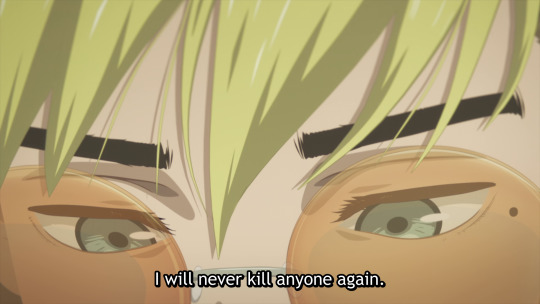
In the English dub, Vash's words are similar: "I’ll never kill. Ever again."
Correct me if I'm wrong, but in the manga and 1998 canons, Legato is in fact the first person that Vash ever actually kills.
Though arguably he does hurt people very badly in the manga, his pacifism is generally about doing the least possible amount of harm to resolve a situation.
So when Stampede Vash says he HAS killed in the past, what is he referring to? Is it his guilt over The Big Fall? Nai did a number on him by retroactively making Vash feel as though the blood of that is on his hands, by showing Nai the access code to the SEEDS05 computer. Or is there something else that happened that we haven't seen yet, something where Vash ended up actually killing someone himself?
I think either way there's a difference between the Vashes here. 98 Vash is the most pure in his pacifism. He even goes out of his way to avoid harming anyone at all, if he can. He seems almost paralyzed by it at times, it even makes him freeze up in situations where he is faced with the choice to kill. 98 ends with him rejecting his obsession with Rem in order to stop Knives.
Manga Vash is frankly not afraid to draw blood, though he avoids it if he can. He has a lot more anger and escalates his willingness to harm with the danger of the situation. His refusal to kill is very tied up to his refusal of his own suicide and Rem's blank ticket speech. After Tesla, he chose to live because of Rem's love. Rem's love also saved the humans of NML. There's a whole transference here with him, where he needs to save the humans as part of him continuing to save himself from that suicidal urge that hasn't really gone away in all that time. And when he does finally give in to that suicidal urge at the end of Trimax, he does it with the mental context of giving his tomorrows to humanity just like Rem did. He embraces Rem’s path even more.
Stampede Vash though-- There's still a lot we don't know about what happened after Tesla. We know Rem gave the blank ticket speech. In the more limited examples we have, Vash absolutely minimizes harm to others, largely by drawing fire and running from it, and minimizes harm to himself. He is extremely controlled and precise in his use of force, again escalating only as much as absolutely necessary. He is actively trying to defuse situations and bring people together. The only times we really see Vash threaten anyone are his confrontations with Knives, and there's no sense that his heart is in actually harming Knives at all.
So is his pacifism a mixture of guilt over the Big Fall, and a need to carry on Rem's work and keep the humans and plants of NML alive just a little longer? Is that really about pacifism at all? If he did try to kill himself after Tesla, which is likely, how much is that driving him here? He is carrying a lot of pain, guilt, and shame, given his regular self-punishment.
And then there's this, in the same scene:
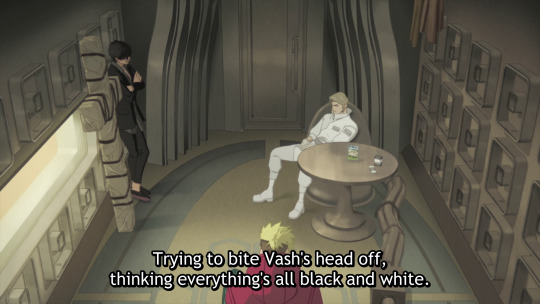
Brad tells Wolfwood that Vash's desire to save everyone on NML including Knives, is actually right.
This is absolutely fascinating to me. In 98, Brad is deeply antagonistic to Vash, partly out of jealousy over Jessica, but also because Vash goes out into NML and fights while Brad and the others in the Flying City hide in fear of "outsiders." Brad is a narrative critique of Vash's violence, and in the end he switches over and defends Vash, dying to save him.
In the manga, Brad is deeply antagonistic to Vash again out of jealousy over Jessica, but also he explicitly calls Vash a monster for his part in July and the Fifth Moon. Again, Brad serves as a critique of Vash, this time about the extreme destruction he's capable of. This is similar to Wolfwood's post-Dragon's Nest moment of doubt, where he seriously considered killing Vash to prevent Knives from using Vash's power ever again.
Stampede Brad is a narrative voice again, first antagonistic as his other counterparts, suspicious of Vash's very nature. But quickly enough he comes around and ends up as one of Vash's parental figures. And when Wolfwood doubts Vash for wanting to save everyone, Brad defends Vash. He says Vash is strong enough to find a way to make his dream happen. In contrast to so many others, instead of telling Vash to take a side, Brad says everything isn't black and white. And in fact SEEDS03 is actively working on a solution that will help Vash's dream happen, by trying to terraform NML with flora.
I think more than anything, Stampede Vash is defined by hope. He has people already trying to make a better NML. He goes out into the world and helps people and stops violence in order to keep plants and humans alive long enough for Luida's terraforming plan to succeed.
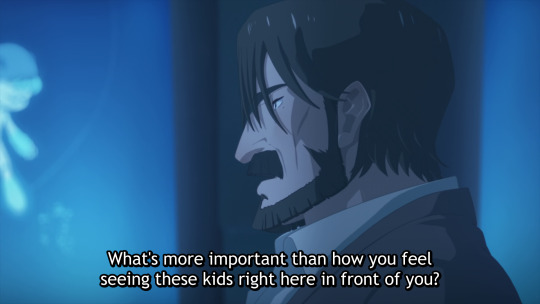
Roberto is another narrative voice. In "Humans", when Conrad shows off his work, all in the name of remaking the human race for survival without plants, Roberto calls him out, saying that his dream is not worth the cost of his monstrous abuse of innocents. Knives and Conrad's "dream" is one of humans and plants living completely separately, without depending on each other.
All of which is to say, in 98 the core inner conflict was Vash's fixation with Rem, and his refusal to kill reflected that. In the manga, the core inner conflict was the transference of Vash's denial of suicide, and his refusal to kill reflected that.
Stampede's core inner conflict so far appears to be abuse and isolation vs love and connection. The struggle of finding a way to survive while minimizing harm to others. This changes Vash's refusal to kill yet again. And all the more fascinating if Vash has already broken that ideal, if it's not a psychological block or obsession like 98 and the manga, but the choice he makes from lived experience and regret. Vash as a kind person having suffered greatly to learn his kindness.
All of which has massive ramifications for story elements that are entirely focused on Vash's refusal to kill. Such as Wolfwood. Perhaps that's part of why Wolfwood's story arc from the manga has already been largely completely by "High Noon at July". Wolfwood might still have no obvious compunction against killing, but Vash has already started to open up his heart. Wolfwood killed Rollo because he had no hope for Rollo or himself. And then Vash gave him hope for Livio, which is far more important to Stampede Wolfwood than what level of violence he should use. Even Livio shooting himself didn't take that away. Despite the destruction of JuLai, Wolfwood ends Stampede S1 with hope, for Livio and maybe even himself.
And also such as Legato. Perhaps that's why Legato's 98/manga obsession with Vash has been refocused towards Wolfwood in "Once Upon A Time In Hopeland/WOLFWOOD". Though I could certainly see Legato plotting a Death Game in revenge for "High Noon at July". Wolfwood is a safe target for Legato to transfer his anger at Knives. The big brother who needs to have his little brother taken away from him for his own good, to purify him.
Fascinating that Legato actually feels anger at Knives here, vs manga Legato who seems to be willing to accept any denigration with the eternal hope that Knives will show him a tiny speck of approval one day. Manga Legato wanted to destroy Vash as a gift for Knives, as proof of Legato's faith. Stampede Legato wants to punish Wolfwood because he can't punish Knives.
#trigun meta#trigun#trigun stampede#trigun maximum#trigun 1998#vash the stampede#nicholas d. wolfwood#legato bluesummers#trigun brad
199 notes
·
View notes
Note
maybe this is just my very hot take but I think people who want gojo to be relevant in jjk beyond what he has already done so far don't get the story. anyone who criticises yuuji as the mc doesn't understand jjk. it's confusing to me how gojo's entire goal is to prepare a new generation of sorcerers to be able to overthrow the system, seeing the young generation consolidate after his death even in such a disastrous situation and having such a big focus on the difference between gojo's generation and the kids and then having readers say stuff like "I want gojo to come back to defeat kenjaku". I swear it doesn't make sense to me how you read a story for over 200 chapters and still miss the point. yeah it's understandable to not get all the references or symbolism but the core of the story, really? the main message? I agree that there's criticism to be made about jjk and I'm one of the first to jump on the wagon when it comes to certain things but I really think gege receives an undeserved ammount of negative criticism for jjk. I also think gojo's death was obvious for a very long time but anyways. hope you have a good day, nico :)
Piping hot take, scalding even, but also one that I completely agree with.
I'd also like to point out that despite Gojo's position as the strongest of the modern era, and therefore someone that you would expect to have a large impact on the story by winning the fights that he's in, has never actually won a significant fight in the antagonists' favor.
The Jogo fight? Jogo and Hanami get away. The Goodwill Event? Hanami gets away and Mahito steals 3 death paintings + the school's supply of fingers. The first Toji fight? He loses and Riko dies. The second Toji fight? He wins, but it doesn't matter because killing Toji at this point wasn't necessary. The Shibuya fight? He gets sealed with the only major loss for the antagonists being Hanami and the transfigured humans in b5f. The Sukuna fight? He dies without dealing any lasting damage to Sukuna.
But it isn't just Gojo that isn't getting anything done for the older generation. Nanami dies to Mahito without killing a single antagonist in Shibuya. Mei Mei flees after almost dying to Kenjaku. Naobito flat out dies to Jogo after the Dagon fight.
As a matter of fact, the antagonists dealt more damage to themselves in Shibuya that anyone from the older generation of Sorcerers did. Choso quite literally takes himself out. Toji kills Dagon after Megumi makes it possible for him to get to him before taking himself out. Sukuna kills Jogo. Kenjaku exorcizes Mahito after Yuuji and Todo + Nobara nearly kill him.
Even more recently, you have Yuki dying to Kenjaku and Kashimo also dying to Sukuna.
All of this only reinforces the point that the story isn't about Gojo or any previous generation accomplishing anything. They're there to be an example; to show us, the audience, how jujutsu society operates and fails it's sorcerers, and to reinforce the themes of the story, but more importantly, to be an example for the students of what they need to surpass in order to achieve what no other generation could.
There are things that I absolutely will ctiticize Gege over - namely, his extremely limited use of his female characters that aren't Maki - but I agree that there's a lot of stuff that the fandom gives Gege shit over that they wouldn't if they understood/cared about the story more. Gege isn't a bad writer and JJK hasn't gone downhill as much as people like to say it has. Likewise, he isn't a bad writer for killing Gojo when everything in the story leading up to that point told us that Gojo would not and could not win that fight. And he won't be a bad writer if he never brings Gojo back when there isn't a single good reason for him to do so.
Which leads us inevitably back to the same question that I asked a while ago: For the people that fully believe that Gojo is going to come back; Why do you want that to happen and how would it benefit the story?
#i hope you have a good day as well anon 💙#jujutsu kaisen#jjk spoilers#answers#anon#meta answers#nicos meta
131 notes
·
View notes
Text
thoughts on episode 7 of opla!
given that arlong park is supposed to be the climax of the east blue saga, i'm a little tiny bit disappointed with how this episode played out, especially given how standout episode 6 was. some of the disappointment comes from me not liking some of the creative choices they made with it, but some of it is also just the limitations of the medium
emily rudd's performance of nami, especially during the scene where she's stabbing her arlong tattoo, was absolutely phenomenal. all the actors in this show have been doing such an awesome job so far, but at the end of the day, there's no way it can really stand up to the manga and anime versions of this same scene. oda is a masterful artist, and the way he's able to depict such raw despair and grief has always been one of my favourite things about his art. and one of the things about animation is that they're able to exaggerate certain expressions and body language to give more of an emotional impact, in a way that real humans can't really do, so i feel like in some ways, live action is always gonna fall short. so far the live action has been doing a good job of adapting the story in a way that plays to the medium's strengths, but i do feel like this was a rare L for them. and that's not to say the episode wasn't well done! because it really was. i think that in this case it suffers from having to try and live up to the source material.
i'm not sure how i feel about them having nojiko not knowing about nami's plans. i think one thing that i really liked about this arc in the manga was how all the villagers knew nami was trying to buy back the village, but they were being hostile to her because they knew how hard it was to do what she was doing, and if it ever got to be too much for her, they wanted her to be able to turn her back on them without feeling bad. they didn't want her to feel obligated to save them. that's neither here nor there though, and it did open up a chance for them to have a heartfelt conversation and make up.
i've seen some people upset that Hachi wasn't part of the arlong park arc, and i was a little sad we didn't get to see him too, but i do also think that it makes sense as a creative choice. so far when you look at the storytelling choices they've made with this series, a lot of their decisions seem to come from the mindset of "don't assume we're going to get more seasons, but lay down a bit of subtle groundwork just in case we do" and this seems to be one of those choices. in the event that we ever do make it to the sabaody archipelago, hachi is going to become a friend, and it's going to be easier to get the audience on his side if he wasn't one of the antagonists that was enslaving nami's village. in the event that we do get to sabaody, i'm assuming we're gonna get some flashbacks to nami's childhood when he WAS with arlong, but then he left before the canon timeline because he couldn't deal with how awful arlong is? i don't know, but that's just a guess. the manga had the leisure of slowly winning the audience over to his side by the simple fact that we were able to spend so much time with him, he was around for many chapters and we were slowly able to get attached. but the live action is going to have a much more limited run time, so we won't have the time to do it that way. this decision is just a bit of a shortcut. that's my reasoning at least
the flashbacks were well done! i like how sweet genzo seems, and bellemere's actress did a good job. she had big mom vibes. i am a bit surprised that they did actually show bellemere slapping nami. i would've thought they'd cut that out. glad they didn't though!
the prosthetics for the fishmen were AWESOME! i'm so so so glad they decided to go practical effects instead of doing it all with cgi, they look fantastic
i LOVE how they gave arlong park more of a waterpark/amusement park vibe. it calls back to the fact that it's heavily inspired by sabaody park, and that, paired with arlong being very defensive when he perceives that he's being looked down on by humans because he's a fishman, work together to show that all of arlong's behaviour is stemming from a place of hurt, and a lifetime of alienation.
i like seeing helmeppo and koby slowly becoming friends! i was really surprised when helmeppo bought a drink for koby, and then it was pretty funny when koby just couldn't help but blurt out that luffy is garp's grandson. they're growing to become pretty good partners
zeff and garp's conversation was good! loved the mention of jaya, and also i think the two of them make good parallels. both grand/parents to some upstart pirates - one of them trying desperately to cling on to his grandson, the other one having to practically push his son out of the nest. zeff tries to convince garp that sometimes you just gotta let go and let your kid tread his own path, but garp still isn't ready to hear that, and maybe he won't ever be ready to hear that.
#opla liveblog#opla spoilers#opla#one piece#monkey d garp#red leg zeff#sanji#monkey d luffy#nami#nojiko#bellemere#arlong#spoilers#op spoilers#koby#helmeppo#hatchan
95 notes
·
View notes
Text
Trapped and Dreaming Freedom


So I've been reading these two webtoons lately about female leads stuck in very toxic and unhealthy relationships (while being aware of it), and I'm loving every second of it!
If you know me, you know I just love a badass cool female lead and I also love seeing characters stuck in very difficult situations and watching how they use their brains and/or skills to get out of it, and both comics excel at these aspects!

First series is "Trapped", a comic about this taxi driver who got tangled by accident with a vampire who develops an obsession with both her and her blood after she manages to outsmart him a couple of times, something that hasn't happened to him in years.
It feels very "Tom and Jerry" with both characters trying to get the upper hand on their relationship, and you would think it would be super one-sided but vampires actually have quite a bit of annoying rules on how they work that severely limit their freedom and our female lead exploits as many of them as she can to make him eat sh*t! It's just glorious!
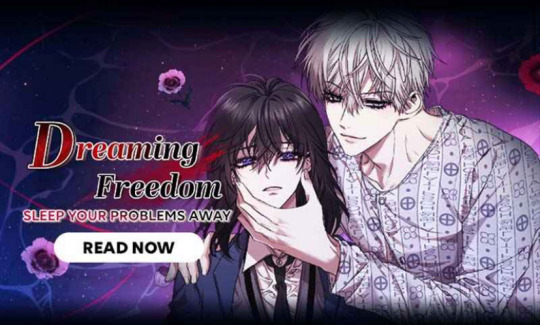
"Dreaming Freedom" is... somehow less dark, and at the same time way darker of a series.
It's not as violent or gory but it deals with more realistic problems that hit closer to home for some like school bullying, abandonment, harassment, family abuse, and so on.
The premise is that our female lead teams up with a guy that has the power to use dreams to affect people in the real world, and they use this ability to get revenge on all the girl's classmates that harassed her, but the more our female lead does that, more the male lead gets obsessed with her and we later find out that he has some serious anger issues making him extremely dangerous.
Our lead basically goes from "I can use him to get payback!" to "Oh my God, I'm the only thing that's keeping this dude under control and away from people!"
It feels like you're being handed a living knife that you just pray won't run out of control or turn itself against you. It's so uncomfortable but at the same time so thrilling!

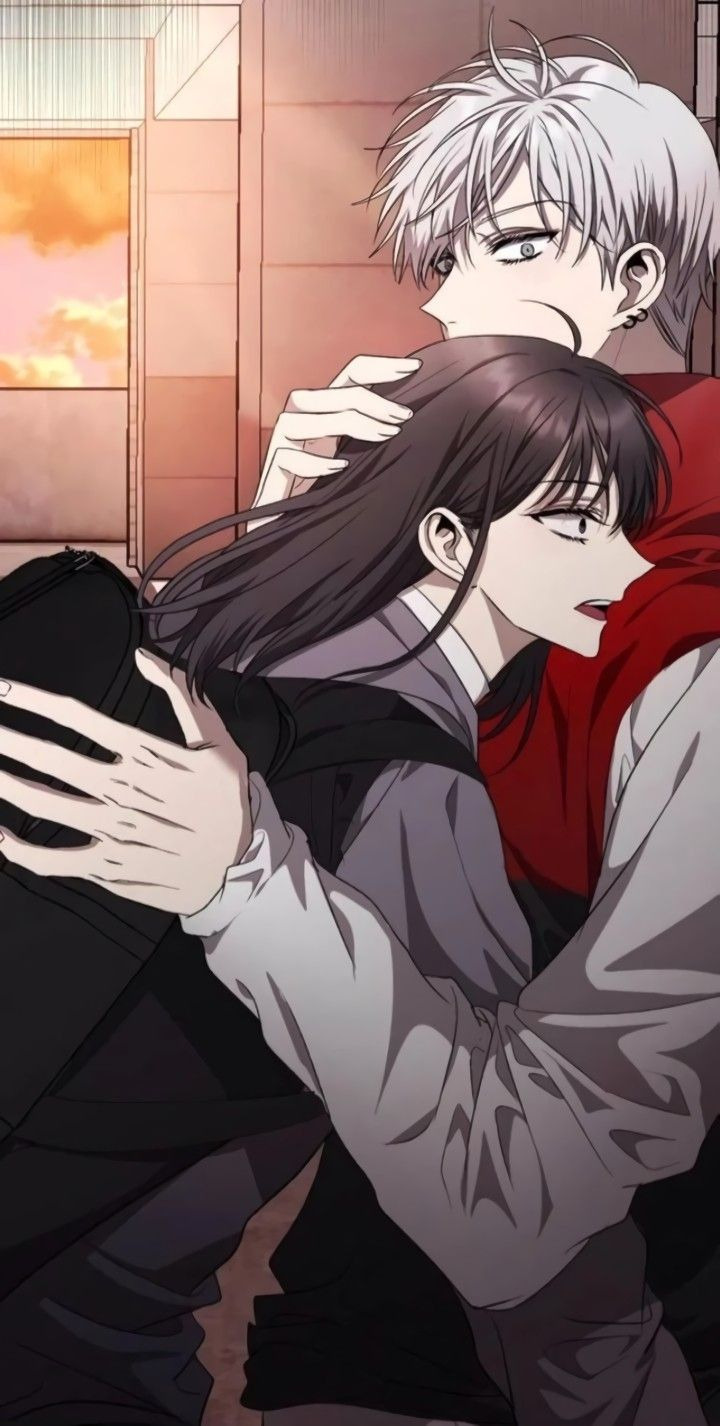
While I really don't like when unhealthy relationships are glamorized and used to send some kind of "Oh, he's kinda dangerous... But at least he loves you, so it's okay, right?" message, I do like it when the unhealthiness of the relationship is the focus AND is painted as a problem that needs to be fixed.
I like how both female leads always call the male leads on their bs and keep them in check whenever they start going too far, and it's fun to see how they use them whenever they're backed into a corner by the antagonists of the stories.
Also like the themes these series explore, about how when you keep dealing with people that act like monsters you see yourself slowly turning into a monster yourself and start to attract other monsters as well, eventually making you question how far can you go? How far should you go? Can you get back from it? And so on.
But most of all, I like that both series make sure to show that these "bad boys" were their last freaking options. Not the first, not the second, but the very bottom of the barrel. They went to them only after they felt they had no other choices and were sure that nobody else would take their side.
This isn't just "Oh, I went to him because he's a hot bad boy", this is "The world turned its back on me so I'm gonna use the only cards that I have left."
They basically made a deal with their devils and now the fun is watching to see how/if they're gonna get out of it.
This is how I like to see problematic relationships. You don't paint them as something normal or something good, you paint them as a hardship that needs to be dealt with and use it to do clever commentary on the worst aspects of humanity so we can learn how to be better and as a source for good and intense drama to make us worried for the main characters and invested in seeing them get out okay.
407 notes
·
View notes
Text
any information given is based off some prior knowledge (within the timeline) unless given by skaia. and guardians only rly know a small portion because its fulled by the green sun which only extends its reach as far as LE is able.
so 2 be clear, our knowledge of what types of game sessions are possible are only because of prior knowledge that is relayed to the reader by someone way ahead of the timeline. like void, glitched, and null session shit. even the notion that most sessions are doomed to fail is based on that retroactive knowledge. not retroactive i mean.. proactive..? shit from the future.
ok so like what the fuck even is a 'successful sburb session' then... this is my guess but there would be a base game, that the players would just not be ment to follow. those quests would be there in a timeline where the player would follow it out, but like not without consequence? i think a sburb session would be the culmination of multiple sessions as well.
some of the qualifications expected of players to fulfill are batty asf. you need to gather enough grist to develop the frog via intelebeam, you need a space and time player, you cant damage the battle field TOO much, but also theres an indeterminate time limit until the white king dies. the play would seem to be to have 12 players one for each aspect, but that would make an op black king, if you have too little players then you dont have enough hands to do shit.
theres this post that explains how the spots left open by murderstuck end up getting filled by the end of the comic by the introduction of the human kids. that brings into question why things turned out that way. one mutated frog was made without all these extra hoops, and karkat mentioned how there wasnt enough time to breed a proper one. and i think thats a parallel to the session. as gross as this sounds, it feels like the game was grooming the players to be those proper gods. the game sacrifices sessions to insure that the last standing group of players will be the strongest not for ruling the new universe but creating the healthiest one.
why not make a bunch of unstable ones? quantity over quality. i think it might end up having to do with shorter universe lifespans. universe B seemed to live much shorter than A when comparing how long trolls and humans have been around. trolls had much more time to develop and this presumably extends to parallel species as well. more advanced species mean more sburb players.
back 2 a what a successful session is, i dont think theres a successful singular session rather than merged ones that make a stable universe. the contents of homestuck ends up reflecting that idea instead of that merged session influencing sburb instead i guess.
but then after that theres questions like, "is a major antagonist for players to rally against important?" or "does the concept of doomed timelines carry over?" but this post is getting too long so quickly, something to unify the players would be important and, doomed timelines would exist because there's just so many time looping parts merged sessions would require for this not to be the case.

34 notes
·
View notes
Text
talking about the seven deadly sins of the hellaverse
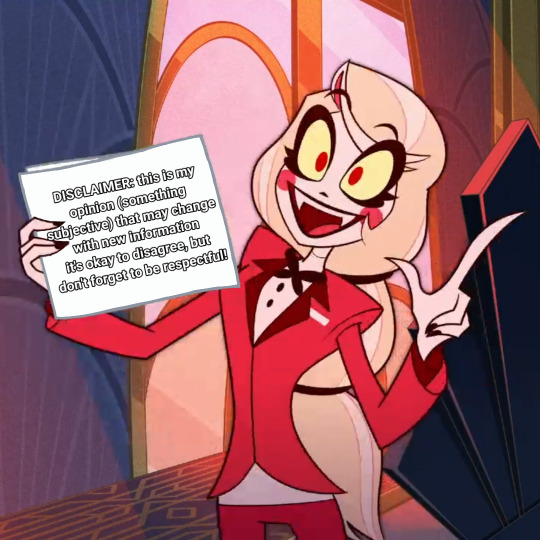
i really hope that the other deadly sins who have not yet appeared are horrible people or even worse than mammon
don't get me wrong, i loved the fact that asmodeus is consent king (it made my week when i saw it for the first time, i felt so happy!) and it was a nice surprise to know that beelzebub is friendly and cared about blitzo's well-being and appears to have no prejudice against imps and hellhounds. and lucifer just wanted to give knowledge and free will to humans and now he's working hard to be a good father
it's a great storytelling, and it makes me want to know more about the characters' pasts.
like for example, were asmodeus and beelzebub wronged in the same way as lucifer for questioning or did they actually fucked up a bit? why don't the three not explicitly appear to be the embodiment of a *sin* like mammon? they were always like this and what heaven was corrupt and unfair and distorted what really happened? have they always been open-minded with hellborns or has that changed over time? why?
i really hope that many of these questions are answered later in one of the series, it has a lot of potential and would make the characters deeper!
and now about mammon and the other sins who have not yet appeared:
i think it would be cool for the other sins to be horrible and really powerful, as a major threat
in both helluva and hazbin there are characters who are not at the top of the hierarchy and can be intimidating and change this pyramid a little, like striker and carmilla with the angelic weapons, moxxie's father's plan in s02ep06
alastor uses emotional manipulation tactics with people he knows are more powerful than him, that's how he got the deal with charlie and managed to get on lucifer's nerve in hell's greatest dad
and the whole scheme that valentino managed to do with angel to the point where he was afraid that charlie could be hurt and kicked her out of the studio (this actually deserves a post just about it in the future)
and all of this is incredible and very well done! there are other ways to be in control and have power
but i miss characters who are a threat as much as power and emotional, someone at the top of the hierarchy, at least in the hierarchy of hell
like how exorcists were feared before they discovered their weakness, or those angels that lucifer is afraid of because of what they could do to charlie in more than anything.

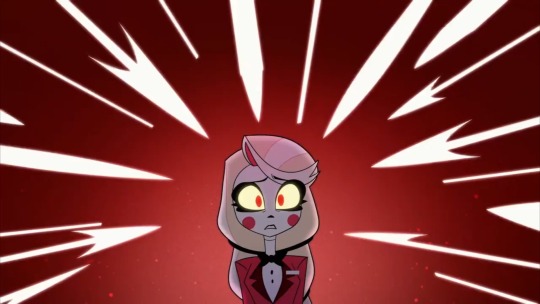
it makes it seem like a threat because we don't know how powerful this character is, we don't know their limits, we don't know what could happen
i think that having these two types of antagonists (those who are at the top of the hierarchy and those who can be a threat even though they are not at the top) makes the series much deeper and more complete
i'm curious about mammon's plan and i hope he's planning big things too
i also think it is more believable to also have more powerful beings who have fallen because they are genuinely bad people, and not just the sinners, overlords and hellborns who can be evil. just like in heaven there are bad people and good people
i also don't think there's a way to have a good trait in wrath and envy lol
we already have 3 sins that are not evil, and one as an antagonist, so i think it would be cool to have more villains/antagonists to be more balanced and believable
and since seven is an odd number, maybe the sin of sloth could be totally neutral, are they just too lazy to choose sides? that would be cool and funny i think xD
anyway, that's all i had to say. if anyone made it to the end, thank you for reading! c:
#my post#hazbin hotel#helluva boss#hazbin hotel constructive criticism#helluva boss constructive criticism#helluva boss beelzebub#helluva boss asmodeus#helluva boss mammon#lucifer morningstar#suggestion
41 notes
·
View notes
Text
One of my all-time favorite antagonist organizations in the entirety of DC is the Court of Owls, and it's a guarantee that I'll eat up anything that features them. But my favorite thing in regards to them is the fact that Dick Grayson could've very easily been a Talon.

Case and point!
I dislike the New 52 era of DC for a number of reasons, but one thing I do think they got right was specifically how they handled the Court of Owls in regards to both Bruce and Dick, and the dialogue in this sequence here is some of the best in my opinion purely because of the reveal of what could've been had Bruce been just a little later to bringing Dick into his home.
If you look at Nightwing and consider just how powerful he is on his own as an unaltered human, and if you look at the Talons and how viciously deadly they were against the various members of Batman's family, and then you combine them?
Obviously, taking into account the different way Dick would've been raised means assuming he would lose some of his leadership and detective capabilities because— considering that Talons are all essentially mindless assassins that have to be told what to do and when to do it at every moment— he never would've had the opportunity to be an individual, or to be a leader, or to have thoughts for himself that would allow him to problem solve.
But if we're looking at lethality specifically, substituting those features for the electrum injections that would give him superhuman healing and senses, and the training that would teach him to disregard pain and emotions would remove the human limitations that he would be otherwise restricted by.
Combined with Dick's acrobatic flexibility (assuming the Court would allow him to continue maintaining it, with its many uses and advantages), the Court's training to withstand a multitude of different circumstances in battle would turn him into one of the most useful weapons in their arsenal.
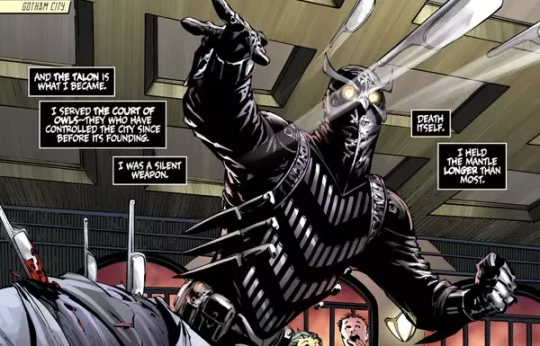

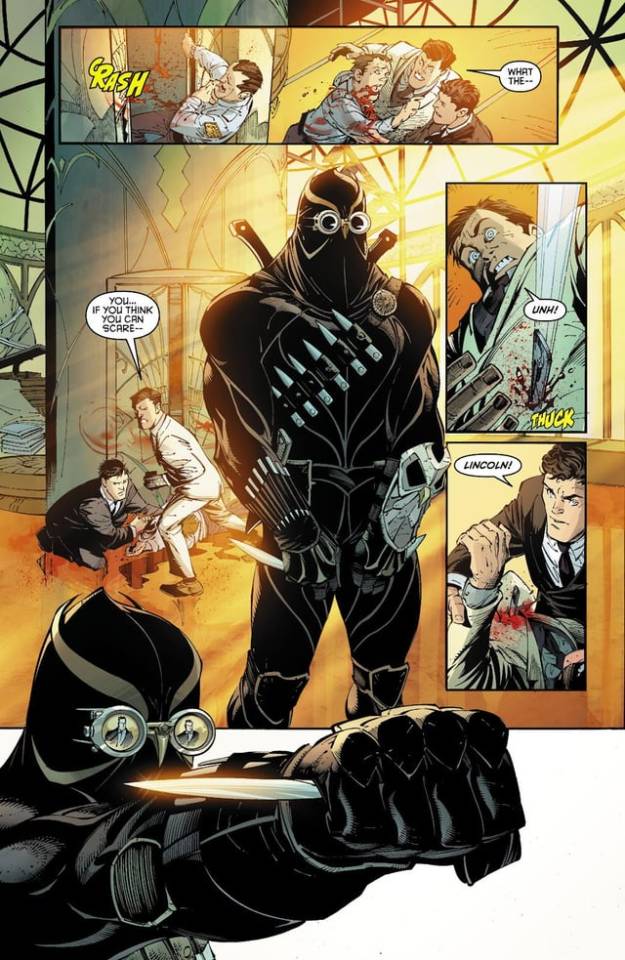

The imagery of the Talons, as seen above, is also incredibly fitting to the themes of Dick throughout the years. The most glaring and obvious of which is the bird symbolism, which I'll refrain from going into detail about because of how obvious it is.
But there is definitely a fairytale-esque quality to them with the nursery rhyme that, in my opinion, fits very well with Dick's upbringing in a circus.
Circuses are often all about maintaining a certain level of illusion, painting a picture to portray a story about each act that is, usually, exaggerated for the sake of entertainment. Similarly, the Court utilizes the belief that they're nothing more than a wives' tale to allow them to continue operating from the shadows. At the same time, the rhyme itself paints them as this otherworldly, all-knowing, all-powerful entity and dissuades any thoughts of acting against them on the off chance that someone does believe they really exist. It's whimsy, in the same way that a circus is, because they're using a story and attempting to make the most of how people receive said story.


The story parallels to Dick becoming a Talon instead of Robin also scratches a very particular itch in my brain. There are two paths, but both of them are intrinsically interwoven with Gotham and Batman.
Dick becoming Robin means him joining Batman on the side of protecting Gotham and her denizens from harm and injustice. He doesn't kill because Batman and Robin aren't the judge, the jury, and the executioner. He maintains his humanity despite the literal physical limitations of a human body and the mental and emotional burdens that come with having free thought, morals, and ethics to take into account.
But Dick becoming Talon means joining Cobb and the Court also on the side of Gotham, but from a different perspective. The Court is made up of Gotham's elite— the rich, famous, and powerful who all want control but don't want the target on their back from being publicly in control. He'd be maintaining the skewed perception of what is just and unjust that the Court instills within him. In turn, this would mean fighting against Batman, who undeniably goes against the wishes of the Court's members who profit and benefit from the corruption of Gotham.
There is a sense of devotion that makes them different sides of the same coin, however. The Talons are tortured and brainwashed into submission, forced to ask "how high" when told to jump. Dick throughout his various comic appearances, has shown his intense loyalty to Bruce— a loyalty that rivals that same devotion of the Talons to the Court, especially in his younger years as Robin.
In conclusion to this tangent, Dick Grayson becoming a Talon was meant to happen, that is undeniable, but Bruce Wayne stepping in and stopping that (albeit unknowingly) is the only reason the Court doesn't have a near undefeatable weapon to use as they see fit.
Which just makes me wonder what other disastrous outcomes were avoided by Bruce taking in the other children.
#dick grayson#dc comics#nightwing#robin#batman#bruce wayne#court of owls#talon#the new 52 and i have beef but i will begrudgingly admit to loving how it handled the court of owls
28 notes
·
View notes
Text
Luz vs The Forces Of "Good" (Trademark Denied)
I Was a Teenage Abomination isn't a flashy episode of the Owl House. I don't mean it isn't pretty to look at, because it most certainly is. But this episode isn't remembered as much as others when it comes to the plot of the story. Hollow Mind is emotionally revealing, Enchanting Grom Fright is a turning point in the series, and King's Tide is King's Tide. But what about the humble 3rd episode of the series, what does it bring to the table?
The answer to that question, is themes. This episode establishes some important themes of the series. Allow me to explain.
SPOILERS AHEAD

This episode introduces some important characters to the series. Willow, Gus, Amity, and of course, Principal Hieronymus Bump (although I'm not going to talk much about him here). And it uses these characters to introduce the theme tied to them. Success. Or more specifically, excellence.

"I'm sorry. I can't stay. I have to go disappoint my teacher."
Willow is introduced failing, with a mean rival who I will mention in a minute. Although, it's interesting to note what Willow is struggling to do. She, and the bully, have placed value on the creation of an abomination, a specific type of magic, and willow isn't cut out for that. She can't conjure the creature.
But here's the thing. Willow isn't bad at magic. As shown off in that same scene, she has a talent for plant themed magic. She is the shy friend with a talent for herbology.

"What you did with that flower and those plants, it was... wow."
"Thanks, but I'm not even supposed to be doing plant magic."
And here, we run face first into the theme. The Owl House is about identity, and freedom of expression, and a sub-story of that is the contrast between that and perceived excellence. Where Luz, across the story, comes into conflict with people who wish to actively limit expression, the side characters come into conflict with the concept of excellence itself. As in, in the Boiling Isles, value is placed on certain aspects of life, and if you can't perform well in those areas, you have less value. You become half-a-witch.
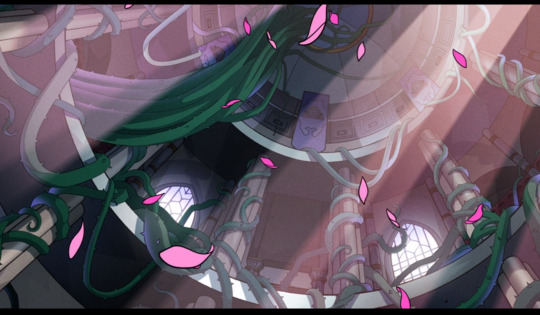
It is Willow's plant magic that saves the day. It is her skill at her own thing that gets them out of trouble, and it's her passion for it that impresses Bump. This shot, for example is viewed in a style reminiscent of the romantic paintings. Not an age filled with love (although there was certainly a lot there) but also an age obsessed with the grandeur of nature. The harsh lighting in this shot calls upon that style, but the subject matter also echoes that, plants growing around columns in a great domed building that you are looking up at. It's meant to make Willow's magic seem more powerful, and to highlight the importance of this moment of self understanding.
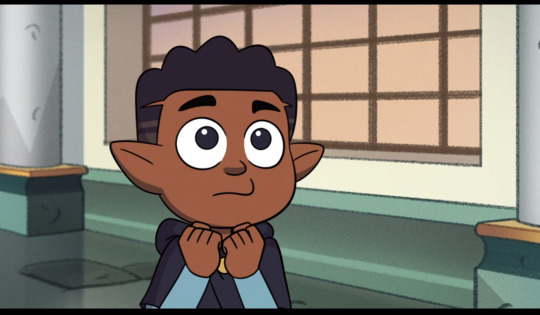
Ok Gus doesn't have much to do in this episode. He's kind of just there. But I will quickly point out his introduction.
"He's the president of the Human Appreciation Society. Most witches wouldn't be able to recognize a human right away. But Augustus is an expert."
Gus is introduced with an accompanying set of accomplishments. It's quiet, and a joke at the time, but this comes back later on. Gus is a character who exists on accomplishments, he has self-worth issues that come up in later episodes.

Amity is introduced as an antagonist. Like Willow, she is introduced as an archetype, the mean school bully, but it is what makes her the villain here that fascinates me. She has fully bought in to the view of excellence. She happens to show promise in the areas in which society values, and as such is granted prestige. Although when that proves unstable (people who are successful in one area can easily be outmaneuvered with enough creativity and brute force of ignorance), she becomes increasingly villainous.

In western culture, moving from left to right is associated with normality. I don't think this is a conscious choice. You could bring up psychology and left brain/right brain tendencies, but I don't understand any of that, so if you want to look that up, go for it, but in the interest of analysis, let's just agree that moving from left to right is considered normal.
Amity blight, in all but one shot she is in, is moving from right to left. At one point, the camera changes angle, so that she can move in a different direction without changing the motion on screen. It's abnormal, moving backwards. The camera is telling you subconsciously that her worldview is backwards.
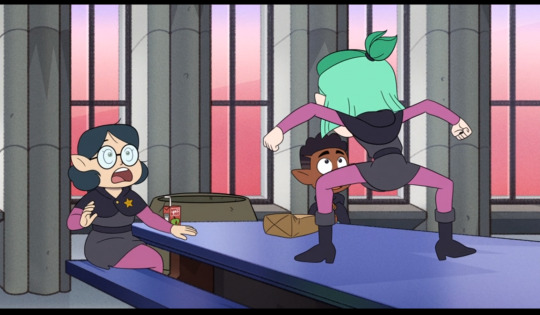
I mentioned an exception to this rule, and that is the first shot Amity is in. In this shot, she moves across the screen like everybody else, but stops, looks back, and taunts Willow. The thing that is holding her back isn't her drive for excellence, it's her lack of understanding that success can come from different places, it's her desire to reenforce the status quo of "you must be good at what I am good at". That is what's holding her back.
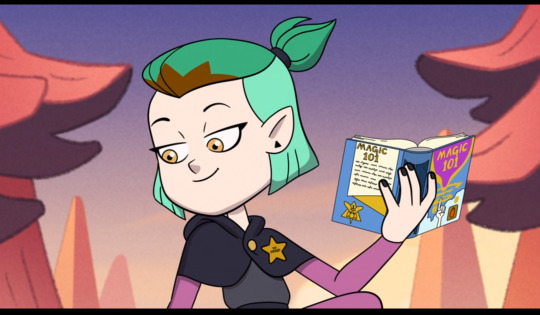
This episode sets into motion the background story of The Owl House, the clash between individuality and excellence, and this keeps bubbling until For The Future, and when I get there, I'm going to look back at the themes set up here.
So stick around, if that interests you.
Previous - Next
#rants#character analysis#literary analysis#literature analysis#the owl house#what's so special about...?#the owl house amity#the owl house willow#the owl house gus#toh#owl house#toh amity#toh willow#toh gus#amity blight#willow park#augustus porter
57 notes
·
View notes
Text
FMA is a weird, special case study in the limitations and pitfalls of the way fandoms create bodies of work.
The trends and tropes of fanwork tend to focus on individual character relationships-- how characters feel about each other, with little or no emphasis on the broader context of those feelings. In a setting with low stakes or simple politics, this is fine. This is why I think AUs that sand off the edges of worldbuilding are so popular. They skip the more difficult foundational Stuff in favor of a quicker, and I would argue much less impactful, catharsis.
The relationships (friendly, antagonistic, familial, romantic, sexual, some combination of these,) are primary in fandom, and everything surrounding them is just set dressing that exists in service to the characters being centered.
In a vacuum, this is generally Fine. Is it intellectually rigorous? No, usually not, but not all art needs to be. Chicken nuggets are perfectly fine with a well balanced diet.
BUT,
This is also how we end up with decades of fanworks that tastelessly recycle a genocide that is foundational to FMA's canon lore into "that thing that makes Roy and Riza sad, sometimes." The "because they did it" is usually in fine print off to the side, unexamined and unacknowledged for the weight it ought to reasonably carry. It's just Angst Set Dressing.
FMA is in no small part about how the people who do the worst things that we can conceive of are still people. "Humanization" is often taken with the assumption that sympathy is being demanded of the viewer, but it is, in truth, just a reflection of reality. People who condone, uphold, and carry out systemic violence are people. This is an important message to internalize for those who are privileged under violent systems. The violent actor is not some mysterious Other. They could be someone you look up to. They could be you.
This is why it's thematically important that Ed gets kicked out of an inn for flashing his watch, which to him, until that point, was an all-access pass. This is why the conclusion of his character arc is that his choices do not exist in a vacuum, even though his privilege offers him the chance to pretend that they do. This is why it's thematically satisfying for Roy to not become the Fuhrer, but to kill him. This is why it really isn't all that surprising that AU Hughes is a Nazi.
FMA03 does not allow the viewer to conveniently disengage with the fact that its protagonists and the people they look up to operate in support an apartheid state. This is literally what the show is about.
Fandom, meanwhile, is almost exclusively about disengaging from that discomfort. This is partially why, back when I was more active in talking about this series and its characters, many people took my pointing out this dissonance as a personal attack. This is why fandom, for all its noise-making about being an escapist counter-culture, is overwhelmingly white. We self-select for it, driving out Black and brown and indigenous voices who object to this willful disengagement from the themes deemed too Icky and Difficult to be meaningfully addressed in our fan works. "It's just shipping, why are you Starting Discourse?" or "I just like these characters and don't like those ones, it's not that deep."
Fandom is deeply averse to critical thought. This will never not feel like a bizarre contradiction to me, but there isn't a nice way to paint it. I know I'm not saying anything new, but the unique manifestation of it in my corner of the internet feels like a case study for why mashing barbies together isn't devoid of context, no matter how hard a given author or artist tries to make it so.
32 notes
·
View notes
Note
Regarding Erlang killing Wukong's monkeys, under what circumstances does this occur? I think the people of the lmk fandom portray Erlang as someone cruel, cold and a tyrant, however, it is also understood that Wukong was an enemy of heaven and Erlang followed orders to burn the mountain.
Lucky for you I just answered this.
I find it very giving that people don't know that Erlang Shen is one of the greatest heroes of legend and it saddens me when there are thousands of years of history showing him as the great figure he is, rather ignoring or being ignorant that Erlang Shen went against Heaven's order to spare Wukong's monkeys in the Nine familial exterminations order and leaving some of his family alive and his mountain still standing. Wukong even says in the Nine-Headed Demon arc how thankful he is to Erlang Shen and sees him as his sworn brother because he was able to spare his home and what few monkeys he could in the burning rather than following the order to wipe out his whole home.
I understand that people are upset with the burning, and they are right to be, but they also have to understand that the severity of Wukong's crimes not only called for his whole family and even his neighbors to be executed but rather his mountain wasn't flattened and he was still having a family to go home to. I know this isn't considered a lot by modern standards but facing complete annihilation instead for Wukong's crimes showed that Erlang Shen knew that the order was too much and didn't follow through it.
Erlang Shen is a complex but overall good and moral character that is going to do what he finds is right. He is considered to be rather a loose canon in heaven, similar to Wukong in that he doesn't always follow an order and rather has his own sense of justice that he chooses to follow. It makes him just as dangerous to heaven as he is also considered a god that puts heavenly officials in their place if they are ever seen abusing their powers. He is the most similar to Wukong in that he cannot be controlled or bribed but rather must make choices himself, thus why he lives on the outskirts of heaven most of the time. If he must follow orders then he does his best to make it that they follow what he deems is fair and it is clear that he didn't think killing all the monkeys in Wukong's family was fair, whether it is because heaven killed his own father and older brother, or that he truly thinks that Wukong's crimes don't fit the punishment is hard to say. Wukong committed a crime that went against the very foundations of the universe, trying to overthrow the JE and take over the position himself despite having no proper training for this role either. This kind of attack would not only put Heaven into chaos, but also all three realms as The Jade Emporer is meant to keep balance between the realms, and if Wukong made one mistake without prop training could’ve had catastrophic destruction on both Earth and the underworld, possibly even leading to the end of humanity if taken too far.
….. so yes, it was a very big crime.
A lot of modern media does take Wukong's rivalry with Erlang to be more antagonist depending on the film or show but more often than not they are to be seen as foils, two sides of the same coin that have gone down different paths. I see a lot of media as well Showing this foil of how Erlang and Wukong see themselves other, and how they are, both limited by society and their own desires to either follow their choices to their own destruction or learning how to change and adapt to their surroundings. Wukong is the one to try to overthrow heaven to fit what he deeps is 'right' through might. And Erlang rather join heaven and choose to change what he deems is 'right' while still within the laws. They are both outcasts (Wukong a yaoguai, and Erlang a product of an illegal union), both fought the Jade Emporer (Wukong for the sake of his status, and Erlang for the sake of saving his family), and both either being punished for their crimes or joining heaven, but only on THEIR terms. Erlang only joined heaven after his mother was saved and Wukong only joined heaven when he reached enlightenment and is no longer under the control of anyone in Eastern Heaven. They ended up in the same place but also refused to give up their personal freedoms as well.
They have similar pasts that make them such good foils. Both of them rebelled against heaven at first but while when Wukong won his first rebellion, rather than being punished he was awarded the position of Great Sage, and got what he wanted. But even then he found that it wasn't enough and ruined the peach banquet, and led to an even bigger fight where he rebelled again. And this time Erlang was his opponent. When Erlang first fought heaven he also won and moved to heaven with his sister San Shengmu and they both agreed to stay in heaven. He was never questioned again and he didn't rebel after being forgiven for his first attack rather making a place for himself in heaven and never being walked over for the circumstances of his birth.
Erlang is actually still considered quite the rebel, even within the heavenly courts as you noticed JE how sent an entire crate of gold just to convince Erlang to fight Wukong. Erlang didn’t fight Wukong because he was ordered or even because of the gold, rather, because he thought what Wukong was going was too far. He might not have joined in the first fight where Nezha and Li Jing were to fight Wukong because he thought Wukong could’ve been justified in his anger, just as he fought Heaven once. But after the eating of the immortal Peaches, immortal wine, and immortal pills, and also abandoning his post and trying to overthrow heaven so he can take does Erlang make a conscious choice to join the fight. But even then the JE had to ask him with the prompting of Guanyin.
From there, two men of similar backgrounds are slighted by heaven, but one chooses to continue to fight and never be satisfied until he is in charge of all of heaven, while the other accepts his position and stays and rather lives by his own freedoms and sense of justice. And tell me, Lotus Lantern could be a deep dive into how Erlang became the same forces that he was fighting against in the first place and how he never properly processed his own trauma of heaven killing his family and rather him fighting himself when he fights Liu Chenxiang. He’s a very interesting character and that’s why people really enjoy putting him alongside Wukong as they both have generally good intentions, being considered strong family men, but somewhere along the way, they still lose who they are and in the end, hurt their family due to their actions and short-sightedness. Wukong puts his monkey in the crossfire due to his own crimes and Erlang arrests his sister despite him being a product of the very same crime she has committed, almost condemning his own existence.
These two are such great foil characters, they are so similar and they are so complex in both their good intentions but also how they remain so human and reliable despite being gods.
#anon ask#anonymous#anon#jttw#journey to the west#sun wukong#xiyouji#lmk#lego monkie kid#lego monkie king#monkie kid#yang jian#ask#erlang shen
79 notes
·
View notes
Text
G Gundam Prelude: The Real Robot vs Super Robot Debate

So before I begin talking about Mobile Fighter G Gundam, I'd like to take a minute to preface that conversation with a companion piece of sorts. This involves the nature of how the mecha "genre" of anime is divided into two subgenres, and how this subdivision (*synth and bass solo play at the same time*) is often used as a sort of dick-measuring contest by fans to argue that their preferred genre is better than the other.
Tetsujin 28-go, Mazinger Z, and the "Super Robot"

To understand the two sub-genres, we first need to understand the general history of the mecha. Technically speaking, our story really starts with Osamu Tezuka's Mighty Atom (Astro Boy in the west), but the giant robot style of mecha would not appear in earnest until Mitsuteru Yokoyama's Tetsujin 28-go (Gigantor in the west) and Go Nagai's Mazinger Z. Tetsujin and Mazinger would go on to codify a lot of the tropes common to a lot of these early robot series alone. If it wasn't either of those two, chances are likely Ken Ishikawa's Getter Robo will have you covered.

These so-called "Super Robots" were known for their superhero-like power sets. They were usually powered by either nuclear power or a fictional power source such as Photon Energy or Getter Rays. Almost every single robot in these stories were made with some sort of Super Alloy (or Chogokin), and each super robot had a whole arsenal of weapons, including but not limited to swords, axes, drills, lasers, and, of course, the rocket punch. These super robot series would dominate a lot of Japanese television for most of the 70's. But behind the scenes, one man would be forging his own path. And at the end of the decade, he would release a show that would turn the canon of mecha stories on its head.
Gundam, VOTOMs, and the "Real Robot"

In 1979, the anime series Mobile Suit Gundam would air on Japanese television for the first time. This is one of the many mecha series directed by anime legend Yoshiyuki Tomino, and follows a direct lineage from his other works such as Brave Raideen, Zambot 3, and Daitarn 3. Gundam, however, would herald a new style of mecha stories thanks in part to it ditching a lot of the more fantastical elements of its "super robot" forebears in favor of a more grounded war story. These would be the so-called "real robot" style of mecha stories, and would further be codified by Ryousuke Takahashi's first two series, Fang of the Sun Dougram and Armored Trooper VOTOMs.

The "real robots" were a hard departure from their super robot brethren in that they were grounded in reality. Gone were the super alloys and the fantastical weapons, which were now replaced with weapons similar to that of a modern military. More importantly, the stories were now about wars, not with aliens as the antagonist, but other people. Humans. These stories would dominate a lot of the 80's, though the more traditional robots of the 70's would still be around as well.
There's just one problem with the term "Real Robot." The realism doesn't come from the machines themselves.
The Realism of Really Real Robots (It's Not What You Think It Is)
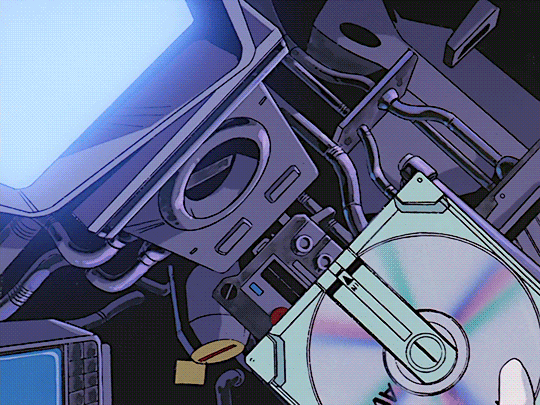
(Wanderer Not Mention Patlabor Speed Run [IMPOSSIBLE])
One of the issues with the term "real robots" is the fact that the realism in most "real robot" shows does not necessarily come from the robots themselves. Take blog favorite Patlabor, for example. Part of what makes the Labors as realistic as they are is not necessarily due to the imagined mechanics behind these machines. It's how the existence of these giant machines changes the lives of the characters. It's little things like how having a special police division that's devoted to Labor crimes is a bit of a money pit, or how SV2 has constant insurance problems due to the fact that Division 2, even in their best moments, are just as destructive as the people they're supposed to stop.
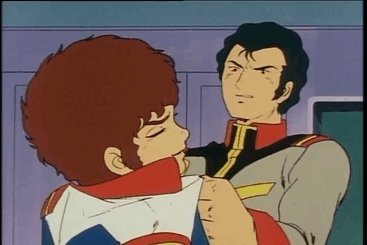
Or take the original "real robot" series, Mobile Suit Gundam. The realism does not lie in the design of the RX-78-2 Gundam. The realism comes from the One Year War and how it affects all of the characters. We can see this in how badly it affects the Gundam's pilot, Amuro Ray, as the poor sod of a teenager basically develops PTSD throughout the original show's run. And it's not just Amuro that's under a lot of stress. The infamous Bright Slap happens not only because Amuro refuses to get back into the Gundam, but because White Base captain Bright Noa (who's 19, by the way) is also at his wit's end. Never mind the fact that the slap makes everything worse.
So What Does This Have To Do With G Gundam?
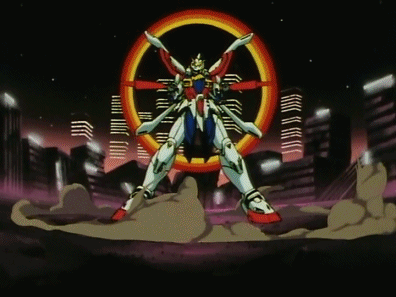
Everything. There's this idea that being a "real robot" series is what gives Gundam its bite and that G Gundam spits in the face of Gundam's original vision by being a hot-blooded "super robot" anime. There's just a couple of problems with that line of thinking. First, it's insulting to the series to say that it has nothing worthwhile to say. Y'know, G Gundam. The series that opens with the Gundam Fight (the Future Century replacement for traditional war) making its way to a ruined Rome, where the poor people who could not afford to leave for the space colonies are panicking as the Gundams literally crash onto their homes. The series where some of the last dialogue of the series is how, even after defeating the imminent threat that was the Devil Gundam, there is still work to be done when it comes to fixing the world, namely by finding a more sustainable replacement to the Gundam Fight. This doesn't even touch on the fact that all of the nations of the world join forces to face an threat that could wipe out all of mankind.

Second, and the part that I think is more insidious, is the idea that G Gundam is a lesser series because it went for more of a classic robot anime vibe as opposed to the serious war story that Gundam is known for. I say this is insidious because it not only ignores the fact that Gundam had just come off of the heels of the extremely depressing Victory Gundam and needed a bit of a palette cleanser, but it also implies that only so-called real robot stories can have serious storylines. God forbid something like Space Runaway Ideon exist, which is probably one of the most serious classic, pre-Dougram robot series out there, or Combat Mecha Xabungle, which is a really goofy but technically a "real robot" series.

This is also related to the idea that G Gundam is just "dumb fun." This line of thinking I can understand, because let's not kid ourselves here. While I wouldn't call this series dumb, G Gundam is kind of known for being insane (but in a good way). What makes this take just as grating is when a similar series can get away with a similar style of story just because it's not related to an existing franchise like Gundam. A series like, oh I don't know, Tengen Toppa Gurren Lagann. And that's a series that's often treated as somehow being different from most other mecha shows because "it's about the characters." Gurren Lagann is one of those shows, and people often treat it like it's a literary masterpiece while G Gundam, which I'd argue is one of the former's progenitor series alongside Getter Robo and GaoGaiGar, is treated as B-movie schlock. It's not, and I hope you'll join me when I dive into the insane masterpiece that is Mobile Fighter G Gundam.
#anime and manga#mobile fighter g gundam#tetsujin 28#mazinger z#mobile suit gundam#fang of the sun dougram#armored trooper votoms#patlabor#space runaway ideon#combat mecha xabungle#tengen toppa gurren lagann#real robot#super robot
21 notes
·
View notes
Text
Oropo; the ideology of power behind being god: Part 1
This is for @secret-engima .
One of the things villains tend to do or want in fiction is becoming god or just having a god complex due to their insane power (examples down below):
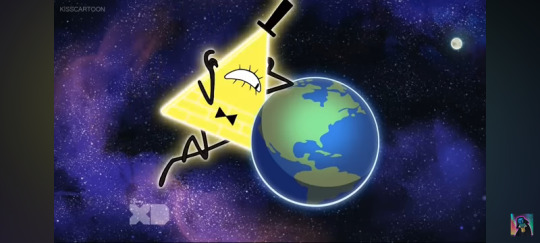
Bill Chyper, big nihilist with unimaginable godlike powers that uses them for his own amusement and entertainment.
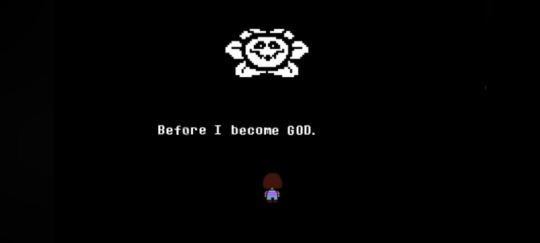
Flowey, a time resetting rogue experiment that wants to become god through manipulation and brute force.
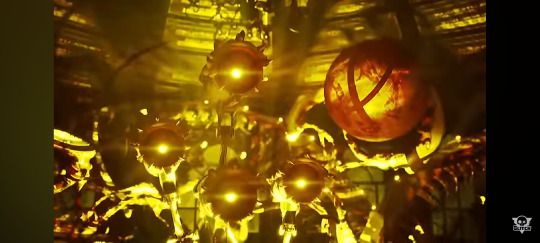
The solver of the absolute fabric, the mechanical equivalent of the antichrist in his show, who plays himself up as the god of his universe.
All of these baddies have in common their insane power level as their main feature and seek to cultivate said characteristic in different ways.
Bill Chyper is a multi dimensional super being that burned down his own world and seeks to do it again in a new one to satisfy his sense of boredom caused by his insane godly powers; Bill, although probably quite sadistic by nature considering the fact that he destroyed his own world, sees himself as a God, but doesn't think to highly of said title nor does he seek even more power and just limits himself to benefitting from its advantages.
Flowey is actually the reincarnated body of a traumatized, dead child that has risen to the temporary god of his world through the ability of rewinding time, and wished to gain even more power through the absorption of souls, so that he could finally break free from his unchanging existence and solitude. In his case, although Flowey already had the powers of a god, but didn't view himself as one so he decided to gain even more power than the one he had.
The Absolute Solver, (this part will be reviewed at a later date) although very mysterious and with an ongoing story going on, seems like a shared IA eldritch entity that can have various hosts each and every one active at the same time with a priority system and has an hive mind identity of his own that gives it a shaky sense of self and seeks to spread that self across the universe with his reality warping powers. The solver is portrayed as the devil while being viewed as god by the human researchers and this leads to an interesting dichotomy in the solver's sense of self.
But while all of this is pretty interesting on its own, I believe there is one villain who took the idea of power and becoming god and took it to a whole new level by building an entire philosophy, ideology and theology around it.
And that villain is none other than the Eliotrope Oropo from Wakfu, the main antagonist of season 3.

For starters even though Oropo in the actual season isn't as competently written as Nox and Qilby, the idea that he had baked into his DNA would have made him by far my favourite Wakfu antagonist, and one of said unique ideas that make Oropo so different from many other fictional villains is his unique spin on the "I want to become/am a god" baddie mindset that he has developed.
You see, from the very start Oropo is an extremely powerful being but not an omnipotent one like Bill, more in line with the base form Absolute Solver and seeks to gain more power like Flowey.
But where he starts to differentiate himself from the others is the complex world view that he develops around the idea of power and godliness. You see, Oropo is a clone of the main character of the show that had his entire race of copies sent back in time to the beginning of everything and had to watch every single one of his siblings die with the gods being uncaring to their situation which sparked in him the idea to replace them. But while a normal person would think that he'd limit himself to just obtain more power and then become the only god of the world, what actually happens is that, in an attempt to prove himself better than the gods, he builds his own new pantheon made out of abandoned demigods, and builds up a tower meant to represent his doctrine from which he'll replace the gods once the time loop ends.
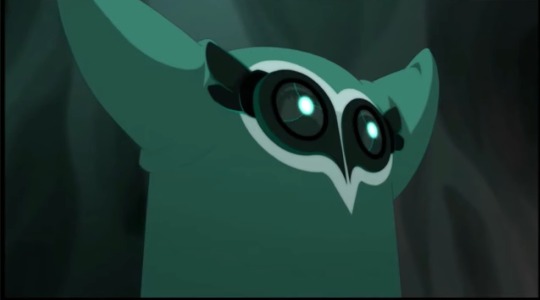
And that's what's really fascinating about Oropo, it's his complex idea of what being a god is like; he doesn't limit himself to just being powerful or gaining more power to obtain everything he wants, no, he has to build a pantheon, a doctrine, his own mythology and have other people who share his ideology to rule alongside him in the hierarchy that he has envisioned complete with his own set of rules and roles which must be obeyed by everyone.
Next part>>>>
#I'm going to bring the murder drones fandom in every wakfu discourse until the two community merge#I have an agenda to spread#gravity falls#bill cipher#undertale#flowey#murder drones#absolute solver#wakfu oropo#wakfu nox#wakfu qilby#wakfu eliotrope#wakfu yugo#wakfu#character analysis
23 notes
·
View notes
Photo

In 2022, Corinne Tan was announced as the American Girl Doll of the Year and heavily promoted as a way of raising awareness about anti-Asian racism during COVID. But what message did her story send?
When Corinne Tan debuted, AsAms were offended by the synopsis and how it centered a white man in what's supposed to be a COVID racism story. Once I heard the book had been fast tracked for two live-action specials on HBO Max and Cartoon Network, I knew more harm was coming. In the rare instances Western media talks about anti-Asian racism, it's downplayed. Instead, narratives are used to reinforce the 1) Model Minority Myth, 2) Asian gender divide, and 3) "correct" levels of assimilation. Unsurprisingly, Corinne Tan’s story does all of these.
There's a place for stories about divorce and blended families, but this story isn't it. COVID racism is specifically about the threat of AAPI being verbally or physically assaulted by non-AAPI. The author's choice to emphasize conflict within an Asian family is inappropriate.
Instead of empathizing with David Tan's inability to work during the pandemic—a real problem that has devastated many AAPI families and businesses—it's the reason Judy divorces him. The story not only erases racism as a reason for AAPI pandemic joblessness, but victim-blames. It implies her parents have an antagonistic relationship because her dad isn't white and rich, and that makes him an inferior romantic partner. Despite referencing a slur meant for Asian men, the story never acknowledges that her dad experiences racism too.
Another appalling aspect is how Corinne, an 11-year-old girl, is responsible for teaching a grown white man to empathize with her experiences of racism—because her mom won't. Not only does Judy never talk to Arne about racism, she lets him gaslight Corinne in front of her. Judy seems fixated on wealth and achievement over her daughters' emotional safety. When the family lived with David, the walls were decorated with the daughters' artwork. In Arne's house, Judy is concerned with protecting the aesthetic chosen by Arne's professional decorator.
This is why the Eileen Gu poster becomes such a sticking point. While David encourages his daughters to embrace Chinese culture in everything, Judy seems to apply it only to her restaurant. Is it because Arne tells her he hoped marrying a chef would mean never buying takeout?
Meanwhile, Arne, a rich white businessman—who calls himself Goldilocks and whose behavior the author describes as "clueless" racism—gets sympathetic treatment. His fear of heights and dogs is equated to Corinne's fear of racists, as if it's a phobia to overcome via willpower.
Recall that the purpose of Corinne Tan's story is to educate about AAPI experiences with racism during COVID. Mattel, owner of American Girl, hired a panel of AsAm academics and consultants to tell her story with "authenticity and accuracy." So how did it turn out so harmful?
It's because the AsAm consultants for this project and many similar projects—like Dr. Jennifer Ho—are out-of-touch with our community. Insulated by wealth and/or whiteness they've chosen, they think they've acknowledged their privilege, but their work shows they're still reinforcing it.

The broader problem is that racist and misogynist white men control media. Regardless of gender, sexuality, or marital status, AAPI are given media power only when they internalize and repeat white men’s messaging. This isn't limited to fiction—it affects real-life activism too.

A picture says a thousand words, and it speaks volumes that Stop AAPI Hate chose to literally center white men in the photo accompanying their hate crime data report summarizing the past two years. Of those "thousands of voices," it isn't hard to guess who's prioritized. Stop AAPI Hate pushes the same message as Corinne Tan's story: racist white men deserve more humanity and sympathy than actual AAPI male victims. Hating and erasing AAPI men is required to show that you're a "safe" Asian deserving of resources and support. (see my data thread about how hate crime data is manipulated to erase AAPI men as victims)
It's bad enough that an entire gender is being cut out from resources and empathy, but what Corinne Tan’s story reveals is another disturbing trend: AAPI youth are being groomed into normalizing having racist white men in their lives, specifically in their families and homes.
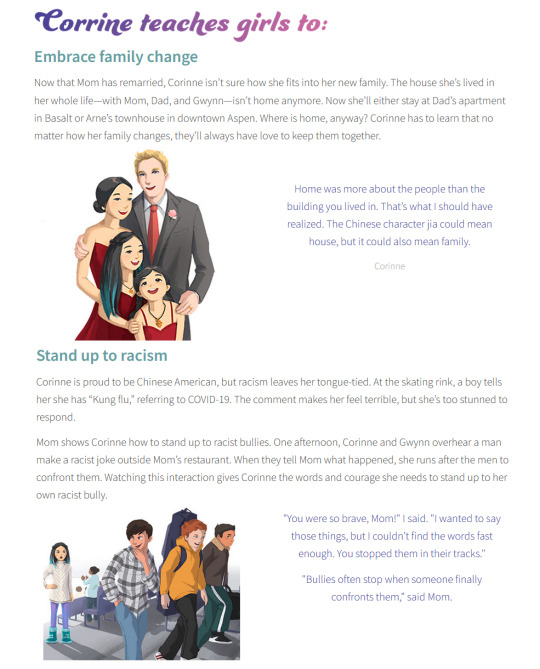
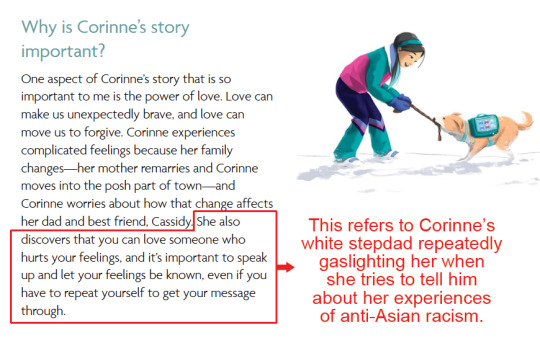
Corinne Tan is a middle grade story (ages 8-12). For its consulting, Mattel partnered with AAPI Youth Rising, a non-profit led by AAPI middle schoolers. At the time, Dr. Ho was president of the Association for Asian American Studies, which helps shape AsAm studies in schools. It's not a stretch to think Corinne's mom Judy, who puts Corinne in harm's way by refusing to address her white husband’s "clueless” racism, is reflective of the behavior of AAPI adults involved in Stop AAPI Hate and other AsAm orgs—they gave the story their stamp of approval.

Anti-Asian hate crimes against AAPI should've brought the community closer together. Instead, we've been segregated further, and the AAPI who hurt the community the most have hoarded the empathy, media attention, and resources for themselves. How can any of us heal like this?
(Please don’t repost or edit my art. Reblogs are always appreciated.)
If you enjoy my comics, please pledge to my Patreon or donate to my Paypal.
https://twitter.com/Joshua_Luna/status/1134522555744866304
https://patreon.com/joshualuna
https://www.paypal.com/paypalme2/JoshuaLunaComics
#corinne tan#american girl#american girl doll#mattel#aapi#asian american#chinese american#asian american representation#racism#anti-asian racism#hate crimes#covid racism#stop aapi hate#white men#gaslighting#grooming#fil am artist#my art#artists on tumblr#joshua luna#josh luna
215 notes
·
View notes
Note
Hello! Do you have any recommendations for ttrpgs like Kentucky Route Zero?
THEME: Kentucky Route Zero
Hello, I looked up Kentucky Route Zero for the first time thanks to your ask and I understand why you’d want to find a game that replicates it to some degree. Let’s establish what elements of KRZ I’m focusing on when providing recommendations.
The game is modern, and feels transient in some way.
The game offers a subtle or unsubtle critique of capitalism.
The game allows for magical realism, in that odd things are accepted by the characters as fact, or disregarded entirely. This is used to draw attention to the strange and might even highlight abuses of power.
The game allows you to contribute to the lore, but characters still feel to some extent that their choices won’t take them where they want to go.
Now, the games I’ve got for you don’t necessarily have all of these elements written in, but I’m suggesting them as avenues that are more likely to point you in this direction.


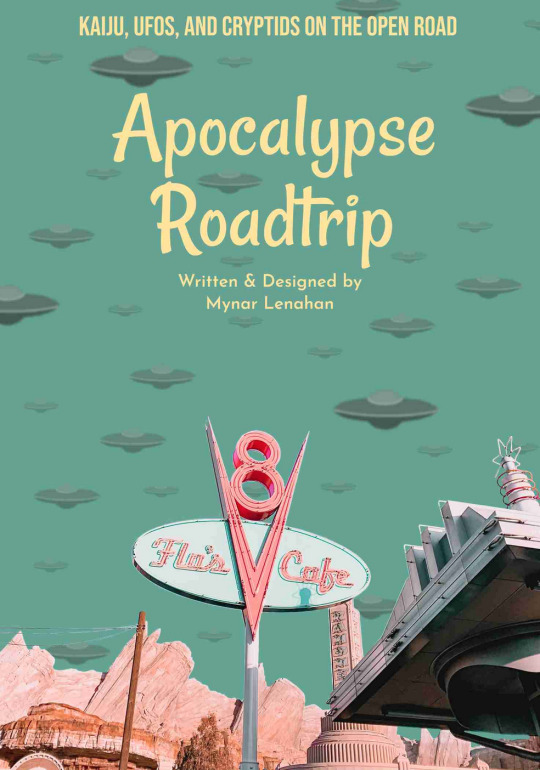
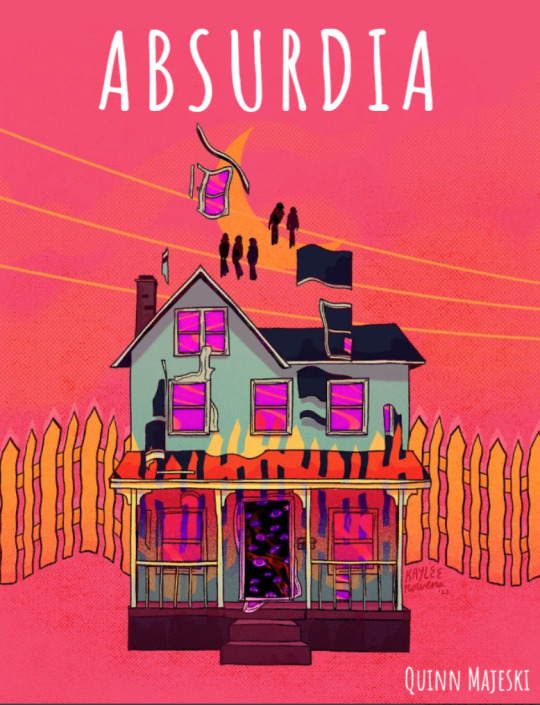
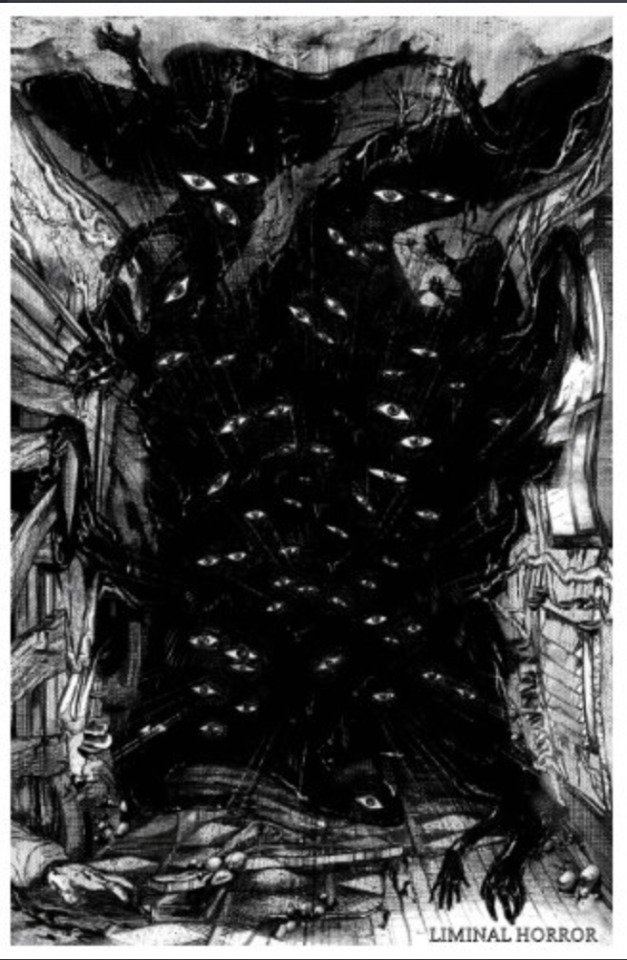

Over the Edge, by Atlas Games.
During your stay with us, please remember that Liberty is Job One, Disarmament Means Peace, It's Polite to Speak English, and, of course, Paranormal Activity is perfectly legal.Thank you for your consent.
The Edge is the weirdest city in the world. Get into trouble. Question your place in the crazed multiverse. Transcend mortal limits. Join a cult. Fight a baboon. Along the way, you might find out who really controls humanity. Unless, of course, you've been working for Them all along.
Over the Edge describes itself as an alternate reality; there are otherworldly entities, large conspiracies, psychic powers, etc. Characters follow “Hollywood” reality: they exist at the culmination of plot-relevant world elements, interacting directly with the conspiracies existing underneath the surface. You are playing a typical protagonist. This means that while playing this game, you are likely to run into pulp-action territory, which might not be exactly what we’re going for here, but what I think this game might really do well is place you in a setting where things are just a little bit off from normal. One of the pieces of art in the Quickstart is of a lady walking her pet hyena: that tells me that we’re probably going to have hefty amounts of Magical Realism in this game.
Midnight Roads, for World of Darkness, by White Wolf.
The roads are lovely, dark and deep…
There are things in the world that no laws account for – things that bestow blessings no man remembers or curses for slights long past. But the things, they do not forget. They wait for the right hand to fall upon them, the right eyes to see their glory, the right heart to recognize their power.
World of Darkness is a long-standing horror roleplaying game originally published by White Wolf. Currently the system Midnight Roads is built for is actually obsolete - having been replaced by the newer Chronicles of Darkness - but the advice and guidance in Midnight Roads is still solid. It focuses on tying real-world fears to supernatural phenomena, and includes a number of example antagonists that make the blank stretches of open road across the United States feel alien and terrifying. Even if you don’t run a game in this system, I highly recommend checking out the supplement for inspiration.
Apocalypse Roadtrip, by Mynar Lenahan.
Apocalypse Roadtrip is a 34-page Forged In The Dark game for 2-5 players about normal people finding their way after the world has ended. Navigating their way past roaming Kaiju, military bombings, otherworldly cryptids, UFO fleets, and other survivors (friendly and not), the characters work hard to achieve their goals and, ultimately, make some changes in their world.
This game is great if you’re looking for that perpetual on-the-road feeling, for transient characters who don’t have a good place to call home. It’s less about the horrors of late-stage capitalism, and is more suited to stories that embrace oddness, especially in a settings where Kaiju, cryptids, and aliens all exist.
If you want to make the weirdness normalized, push the timeline forward from what is established in the book, to a point where all of these events have become old hat for folks - if the aliens and cryptids aren’t weird or strange, perhaps what is weird is how one specific Cryptid keeps entering the chicken coop and doesn’t seem to eat any of the chickens. Or perhaps the government has confiscated a piece of alien technology, but the business owner who found it isn’t acting the same anymore. Your characters will probably find themselves doing odd jobs as the move from one place to another - whether or not they uncover a larger story is probably up to you.
Absurdia, by Quinn Majeski.
Absurdia is an absurdist modern fantasy roleplaying game about the inane hilarity and understated horror of everyday life. Inspired by works of absurd humor, surreal horror, and literary nonsense like Welcome to Night Vale, Alice in Wonderland, Gravity Falls, and the Twilight Zone, Absurdia is an opportunity to indulge in the surreal and outlandish while subverting the absurdity of modern society.
This game takes place in a strange and surreal town of your own making. It's Powered by the Apocalypse, which means much of the direction of the story will unfold as you play, with staggered successes on anything that requires you to roll - this means that any given action is likely to give you a little bit of what you're looking for while also providing obstacles that you didn't expect. It's also well primed for a magical realist kind of atmosphere, since the abnormal and supernatural might be part of the everyday, such as it is for the residents of Night Vale. The designer, Quinn, is excellent at running games that always keep the play group on their toes, and I expect this game designed by them is much the same.
Liminal Horror (and supplements), by Goblin Archives
Liminal Horror brings adaptable modern horror to TTRPGs. It is a rules-lite, fail forward system that leverages creative problem solving in order to create memorable experiences at the table. Players act as 'investigators' navigating a modern world full of terrible and unknowable horrors.
I’m recommending Liminal Horror not just because it does an excellent job of building suspense and making your characters feel less-than-powerful, but also because it’s got a lot of modules and add-ons that help you customize your game. Swineheart Motel, by Kill Jester, is a cosmic horror adventure set in a roadside motel. Tunnels in White, by MeatCastle GameWare, places an old corporation front and centre as a suspicious entity disappearing locals. The Bloom, by Goblin Archives, is about a small town that is hiding something, and seems to be losing people at an alarming rate. You can also tweak the premise of the game if you want to make your characters indentured to their employer, or freelancers just trying to make ends meet.
If you want to see more Liminal Horror options, you can check out the Tales from The Void, a game jam for Liminal Horror modules!
Hopes & Dreams by Fari RPGS (René-Pier Deshaies).
Hopes & Dreams is a rules-lite tabletop role-playing game where you play as young adults who want to make a difference in a world that won’t let them. Government officials are corrupted, your leaders are broken, and the future looks bleak. Play in this original grunge industrial fantasy setting where you and your friends haven’t abandoned hope yet. You still have dreams of what life could be, and are willing to fight for it.
Hopes & Dreams has a lot of potential to give you a taste of Kentucky Route Zero, in the hopefulness present as a mechanic. Dreams & Nightmares are goals and tracks that hit off at a certain point and are guaranteed to shift the story in what might feel like moments that your character can’t control. Fill your Dream? The world changes for the better. Fill your Nightmare? The world changes for the worse. The original game is industrial fantasy but I can see you using the SRD to make a game that is cyberpunk, modern dystopia, or an alternative Kentucky where Consolidated Power is buying up your debt so that they can get free labour.
If you want to get a bit of a peek into the bones of Hopes & Dreams from the point of view of the designer, you can check out this review by Junk History, which includes an interview with René-Pier Deshaies.
115 notes
·
View notes